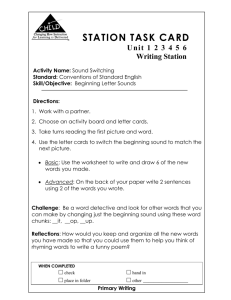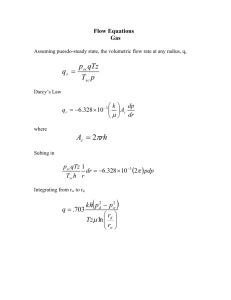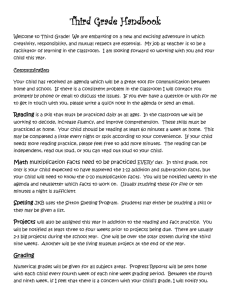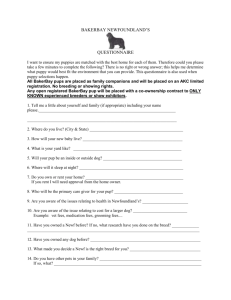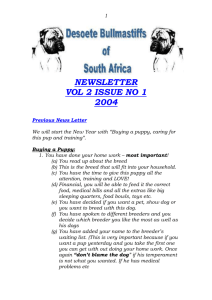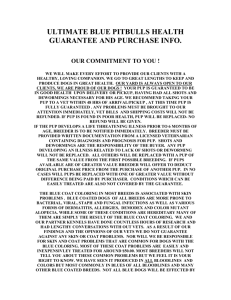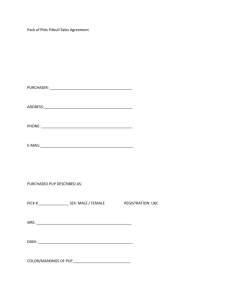What Should I Have For My New Puppy?
advertisement
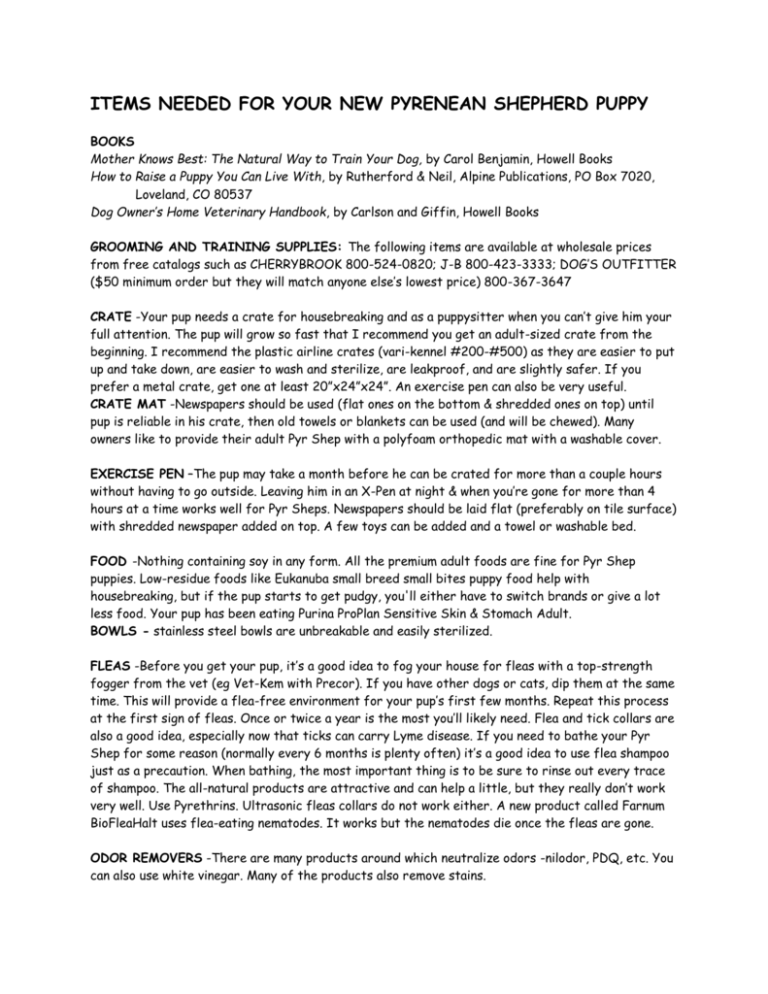
ITEMS NEEDED FOR YOUR NEW PYRENEAN SHEPHERD PUPPY BOOKS Mother Knows Best: The Natural Way to Train Your Dog, by Carol Benjamin, Howell Books How to Raise a Puppy You Can Live With, by Rutherford & Neil, Alpine Publications, PO Box 7020, Loveland, CO 80537 Dog Owner’s Home Veterinary Handbook, by Carlson and Giffin, Howell Books GROOMING AND TRAINING SUPPLIES: The following items are available at wholesale prices from free catalogs such as CHERRYBROOK 800-524-0820; J-B 800-423-3333; DOG’S OUTFITTER ($50 minimum order but they will match anyone else’s lowest price) 800-367-3647 CRATE -Your pup needs a crate for housebreaking and as a puppysitter when you can’t give him your full attention. The pup will grow so fast that I recommend you get an adult-sized crate from the beginning. I recommend the plastic airline crates (vari-kennel #200-#500) as they are easier to put up and take down, are easier to wash and sterilize, are leakproof, and are slightly safer. If you prefer a metal crate, get one at least 20”x24”x24”. An exercise pen can also be very useful. CRATE MAT -Newspapers should be used (flat ones on the bottom & shredded ones on top) until pup is reliable in his crate, then old towels or blankets can be used (and will be chewed). Many owners like to provide their adult Pyr Shep with a polyfoam orthopedic mat with a washable cover. EXERCISE PEN –The pup may take a month before he can be crated for more than a couple hours without having to go outside. Leaving him in an X-Pen at night & when you’re gone for more than 4 hours at a time works well for Pyr Sheps. Newspapers should be laid flat (preferably on tile surface) with shredded newspaper added on top. A few toys can be added and a towel or washable bed. FOOD -Nothing containing soy in any form. All the premium adult foods are fine for Pyr Shep puppies. Low-residue foods like Eukanuba small breed small bites puppy food help with housebreaking, but if the pup starts to get pudgy, you'll either have to switch brands or give a lot less food. Your pup has been eating Purina ProPlan Sensitive Skin & Stomach Adult. BOWLS - stainless steel bowls are unbreakable and easily sterilized. FLEAS -Before you get your pup, it’s a good idea to fog your house for fleas with a top-strength fogger from the vet (eg Vet-Kem with Precor). If you have other dogs or cats, dip them at the same time. This will provide a flea-free environment for your pup’s first few months. Repeat this process at the first sign of fleas. Once or twice a year is the most you’ll likely need. Flea and tick collars are also a good idea, especially now that ticks can carry Lyme disease. If you need to bathe your Pyr Shep for some reason (normally every 6 months is plenty often) it’s a good idea to use flea shampoo just as a precaution. When bathing, the most important thing is to be sure to rinse out every trace of shampoo. The all-natural products are attractive and can help a little, but they really don’t work very well. Use Pyrethrins. Ultrasonic fleas collars do not work either. A new product called Farnum BioFleaHalt uses flea-eating nematodes. It works but the nematodes die once the fleas are gone. ODOR REMOVERS -There are many products around which neutralize odors -nilodor, PDQ, etc. You can also use white vinegar. Many of the products also remove stains. BITTER APPLE -can be sprayed on furniture to discourage chewing, and on the dog to keep him from chewing, or licking a wound. There’s now a formula to use on plants, too. POOP-SCOOPS -The 2 piece work better than the hinged variety. COLLARS AND LEADS For a little pup, use an expandable (8"-12" or 10"-14") cotton or nylon flat woven collar (available in decorator colors including plaid, stripes, and neons!). Get a 6 foot leather, cotton or nylon lead. You may also want to get a “Flexi-lead”. The Flexi-2 is usually sufficient. Do not use chain collar or lead as it is weaker than a nylon choke and the links can rub the pup’s hair off or discolor it. When the pup is 9-12 months old, s/he’ll be mostly grown and you can get a rolled leather collar. DO NOT LEAVE ANY COLLAR ON WHEN THE PUP IS IN THE CRATE! He could accidentally hang himself. For obedience training, you may want to use a round nylon choker --it should be snug enough that the collar stays open rather than with an end hanging down. Remember, the choker is open all the time except for the split-second that you are making a correction. Never allow the dog to pull or drag you. Keep a loose lead. Remember, the point of training is to get the dog to do what you want without much force. This involves lots of praise, flattery, treats, and other motivation, not physical power. TOYS -Pyr Sheps have highly individual tastes in playthings. Most like rawhide chews (don’t get the basted kind as the color rubs off on their fur). They like cow hooves (moo-chews). Some like nylabones, “Hercules” and “Galileos”, and rubber toys, but others turn up their noses. Pups love “Vermont Chew Man” and other fleece toys with squeakys inside. Some like squeaky toys and tennis balls. Encourage him to play “Fetch” – it gives him constructive physical & mental exercize & builds your bond with the pup. Do not play tug-o-war games as that encourages him/her to challenge your authority & builds frustration. Most pups like “Booda Bones” rope toys. “Kong” toys are nice and you can fill them with peanut butter or squeeze cheese and refrigerate or freeze to give to the pup when you put him in his crate before you leave the house. If you choose to give your pup plastic milk jugs or empty soda bottles (with perhaps some beans or rice inside to make a rattle), old socks, shoes, jeans, etc, s/he will have a great time, but don’t expect her to know the difference between new and old. BRUSHES, COMBS, NAIL CLIPPERS - You will need a pin brush (some have rubber tips on the bristles -which are nice) and a wide-toothed metal comb. A slicker brush can come in handy. Get a Miller’s Forge brand heavy duty “big dog” nail clippers. This is all you really need. Every week, starting the week you get your pup, brush every inch of his body with the pin brush (including feet, behind the ears, under the throat, pants and tail, etc). Most Pyr Sheps come to love these weekly grooming sessions. As he gets older and starts shedding, the sessions will get a little longer. Be sure to brush out as much dead hair as you can. This prevents matting and promotes the growth of health new coat. Brush first in the direction the coat grows, then against, then with again. Trim the hair around the anus, and under the pads of the feet as needed. Trim the nails every week, even if you can only take a shaving off. When the pup is little, it’s a good practice to pinch his toenails everyday to get him used to letting you mess with his feet. Make grooming a pleasant experience, but do not allow the pup to bite the brushes or misbehave. If s/he does, say No! firmly and perhaps give him a scruff shake. And NO LAUGHING, no matter how funny s/he is. S/he’ll soon learn that grooming is fun, but it isn’t playtime. It helps to give him/her a rawhide chew to keep him busy. If you brush your Pyr Shep thoroughly every week, s/he will never get mats. But, if you fall behind and s/he does, an Oliver brand mat splitter, or a mat comb will help. You can clean his ears using Oti-clense, alcohol, or a 50-50 solution of water and white vinegar, and cotton balls or baby wipes. For persistent ear infections, try athlete's foot anti-fungal cream. You may find a Grooming Table to be most useful. You can also use the top of a 500 Vari-Kennel. Brushing his/her teeth is also a good idea.
